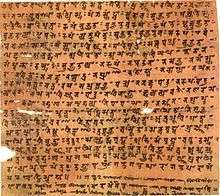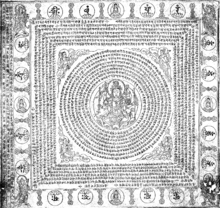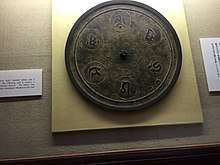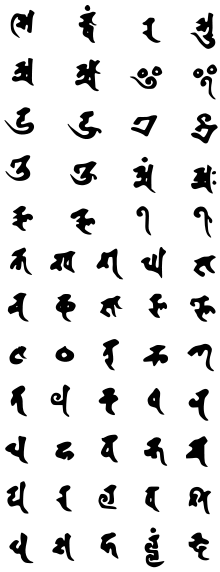Siddhaṃ script
| Siddhaṃ | |
|---|---|
|
The word Siddhaṃ in the Siddhaṃ script | |
| Type | |
| Languages | Sanskrit |
Time period | c. 550–c. 1200 in India, and to the present in East Asia |
Parent systems | |
Child systems |
Bengali alphabet Tibetan alphabet |
Sister systems |
Nāgarī Śāradā |
| Direction | Left-to-right |
| ISO 15924 |
Sidd, 302 |
Unicode alias | Siddham |
|
U+11580–U+115FF | |
Siddhaṃ, also known in its later evolved form as Siddhamātṛkā,[1] is the name of a script used for writing Sanskrit from c. 550-1200.[2] It is descended from the Brahmi script via the Gupta script and later evolved into the Bengali alphabet, and the Tibetan alphabet. There is some confusion over the spelling: Siddhāṃ and Siddhaṃ are both common, though Siddhaṃ is preferred as "correct".[3] The script is a refinement of the script used during the Gupta Empire.
The word Siddhaṃ means "accomplished" or "perfected" in Sanskrit. The script received its name from the practice of writing Siddhaṃ, or Siddhaṃ astu (may there be perfection), at the head of documents. Other names for the script include bonji (Japanese: 梵字) lit. "Buddhist characters" and "Sanskrit script") and Chinese: 悉曇文字; pinyin: Xītán wénzi lit. "Siddham script".
Siddhaṃ is an abugida rather than an alphabet because each character indicates a syllable, but it does not include every possible syllable. If no other mark occurs, the short 'a' is assumed. Diacritic marks indicate the other vowels, anusvara, and visarga. A virama can be used to indicate that the letter stands alone with no vowel, which sometimes happens at the end of Sanskrit words.
History





Many Buddhist texts taken to China along the Silk Road were written using a version of the Siddhaṃ script. This continued to evolve, and minor variations are seen across time, and in different regions. Importantly it was used for transmitting the Buddhist tantra texts. At the time it was considered important to preserve the pronunciation of mantras, and Chinese was not suitable for writing the sounds of Sanskrit. This led to the retention of the Siddhaṃ script in East Asia. The practice of writing using Siddhaṃ survived in East Asia where Tantric Buddhism persisted.
Kūkai introduced the Siddhaṃ script to Japan when he returned from China in 806, where he studied Sanskrit with Nalanda-trained monks including one known as Prajñā (Chinese: 般若三藏; pinyin: Bōrě Sāncáng, 734–c. 810). By the time Kūkai learned this script, the trading and pilgrimage routes over land to India had been closed by the expanding Abbasid Caliphate.
In Japan, the writing of mantras and copying/reading of sutras using the Siddhaṃ script is still practiced in the esoteric schools of Shingon Buddhism and Tendai as well as in the syncretic sect of Shugendō. The characters are known as shittan (悉曇) or bonji (梵字, Chinese: Fànzì). The Taishō Tripiṭaka version of the Chinese Buddhist canon preserves the Siddhaṃ characters for most mantras, and Korean Buddhists still write bījas in a modified form of Siddhaṃ. A recent innovation is the writing of Japanese language slogans on T-shirts using Bonji. Japanese Siddhaṃ has evolved from the original script used to write sūtras and is now somewhat different from the ancient script.
It is typical to see Siddhaṃ written with a brush, as with Chinese writing; it is also written with a bamboo pen. In Japan, a special brush called a bokuhitsu (朴筆, Cantonese: pokbat) is used for formal Siddhaṃ calligraphy. The informal style is known as "fude" (筆, Cantonese: "moubat").
In the middle of the 9th century, China experienced a series of purges of "foreign religions", thus cutting Japan off from the sources of Siddhaṃ texts. In time, other scripts, particularly Devanagari, replaced Siddhaṃ in India, while in Bengal, Siddhaṃ evolved to become the Bengali alphabet, leaving East Asia as the only region where Siddhaṃ is still used.
There were special forms of Siddham used in Korea that varied significantly from those used in China and Japan, and there is evidence that Siddham was written in Central Asia, as well, by the early 7th century.
As was done with Chinese characters, Japanese Buddhist scholars sometimes created multiple characters with the same phonological value to add meaning to Siddham characters. This practice, in effect, represents a 'blend' of the Chinese style of writing and the Indian style of writing and allows Sanskrit texts in Siddham to be differentially interpreted as they are read, as was done with Chinese characters that the Japanese had adopted. This led to multiple variants of the same characters.[4]
With regards to directionality, Siddham texts were usually read from left-to-right then top-to-bottom, as with Indic languages, but occasionally they were written in the traditional Chinese style, from top-to-bottom then right-to-left. Bilingual Siddham-Japanese texts show the manuscript turned 90 degrees clockwise and the Japanese is written from top-to-bottom, as is typical of Japanese, and then the manuscript is turned back again, and the Siddham writing is continued from left-to-right (the resulting Japanese characters look sideways).
Over time, additional markings were developed, including punctuation marks, head marks, repetition marks, end marks, special ligatures to combine conjuncts and rarely to combine syllables, and several ornaments of the scribe's choice, which are not currently encoded. The nuqta is also used in some modern Siddham texts.
Alphabet
Vowels
Independent form Romanized As diacritic with 
Independent form Romanized As diacritic with 

a 

ā 

i 

ī 

u 

ū 

e 

ai 

o 

au 

aṃ 

aḥ 
Independent form Romanized As diacritic with 
Independent form Romanized As diacritic with 

ṛ 

ṝ 
ḷ 
ḹ Alternative forms  ā
ā i
i i
i ī
ī ī
ī u
u ū
ū o
o au
au aṃ
aṃ
Consonants
Stop Approximant Fricative Tenuis Aspirated Voiced Breathy voiced Nasal Glottal  h
hVelar  k
k kh
kh g
g gh
gh ṅ
ṅPalatal  c
c ch
ch j
j jh
jh ñ
ñ y
y ś
śRetroflex  ṭ
ṭ ṭh
ṭh ḍ
ḍ ḍh
ḍh ṇ
ṇ r
r ṣ
ṣDental  t
t th
th d
d dh
dh n
n l
l s
sBilabial  p
p ph
ph b
b bh
bh m
m Labiodental  v
vConjuncts in alphabet  kṣ
kṣ llaṃ
llaṃAlternative forms  ch
ch j
j ñ
ñ ṭ
ṭ ṭh
ṭh ḍh
ḍh ḍh
ḍh ṇ
ṇ ṇ
ṇ th
th th
th dh
dh n
n m
m ś
ś ś
ś v
v
Conjuncts

kkṣ -ya -ra -la -va -ma -na  k
k kya
kya kra
kra kla
kla kva
kva kma
kma kna
kna rk
rk rkya
rkya rkra
rkra rkla
rkla rkva
rkva rkma
rkma rkna
rkna kh
khtotal 68 rows.
- ↑ The combinations that contain adjoining duplicate letters should be deleted in this table.
 ṅka
ṅka ṅkha
ṅkha ṅga
ṅga ṅgha
ṅgha ñca
ñca ñcha
ñcha ñja
ñja ñjha
ñjha ṇṭa
ṇṭa ṇṭha
ṇṭha ṇḍa
ṇḍa ṇḍha
ṇḍha nta
nta ntha
ntha nda
nda ndha
ndha mpa
mpa mpha
mpha mba
mba mbha
mbha ṅya
ṅya ṅra
ṅra ṅla
ṅla ṅva
ṅva ṅśa
ṅśa ṅṣa
ṅṣa ṅsa
ṅsa ṅha
ṅha ṅkṣa
ṅkṣa ska
ska skha
skha dga
dga dgha
dgha ṅktra
ṅktra vca/bca
vca/bca vcha/bcha
vcha/bcha vja/bja
vja/bja vjha/bjha
vjha/bjha jña
jña ṣṭa
ṣṭa ṣṭha
ṣṭha dḍa
dḍa dḍha
dḍha ṣṇa
ṣṇa sta
sta stha
stha vda/bda
vda/bda vdha/bdha
vdha/bdha rtsna
rtsna spa
spa spha
spha dba
dba dbha
dbha rkṣma
rkṣma rkṣvya
rkṣvya rkṣvrya
rkṣvrya lta
lta tkva
tkva ṭśa
ṭśa ṭṣa
ṭṣa sha
sha bkṣa
bkṣa pta
pta ṭka
ṭka dsva
dsva ṭṣchra
ṭṣchra jja
jja ṭṭa
ṭṭa ṇṇa
ṇṇa tta
tta nna
nna mma
mma lla
lla vva
vva- Alternative forms of conjuncts that contain ṇ.
 ṇṭa
ṇṭa ṇṭha
ṇṭha ṇḍa
ṇḍa ṇḍha
ṇḍha
ṛ syllables
 kṛ
kṛ khṛ
khṛ gṛ
gṛ ghṛ
ghṛ ṅṛ
ṅṛ cṛ
cṛ chṛ
chṛ jṛ
jṛ jhṛ
jhṛ ñṛ
ñṛ
Some sample syllables
 rka
rka rkā
rkā rki
rki rkī
rkī rku
rku rkū
rkū rke
rke rkai
rkai rko
rko rkau
rkau rkaṃ
rkaṃ rkaḥ
rkaḥ ṅka
ṅka ṅkā
ṅkā ṅki
ṅki ṅkī
ṅkī ṅku
ṅku ṅkū
ṅkū ṅke
ṅke ṅkai
ṅkai ṅko
ṅko ṅkau
ṅkau ṅkaṃ
ṅkaṃ ṅkaḥ
ṅkaḥ
Siddhaṃ Fonts
Siddhaṃ is still largely a hand written script. Some efforts have been made to create computer fonts, though to date none of these are capable of reproducing all of the Siddhaṃ conjunct consonants. Notably, the Chinese Buddhist Electronic Texts Association has created a Siddhaṃ font for their electronic version of the Taisho Tripiṭaka, though this does not contain all possible conjuncts. The software Mojikyo also contains fonts for Siddham, but split Siddham in different blocks and requires multiple fonts to render a single document.
A siddhaṃ input system relies on the CBETA font, Siddhamkey 3.0 has been produced.
Unicode
Siddham script was added to the Unicode Standard in June 2014 with the release of version 7.0.
The Unicode block for Siddham is U+11580–U+115FF:
| Siddham[1][2] Official Unicode Consortium code chart (PDF) | ||||||||||||||||
| 0 | 1 | 2 | 3 | 4 | 5 | 6 | 7 | 8 | 9 | A | B | C | D | E | F | |
| U+1158x | 𑖀 | 𑖁 | 𑖂 | 𑖃 | 𑖄 | 𑖅 | 𑖆 | 𑖇 | 𑖈 | 𑖉 | 𑖊 | 𑖋 | 𑖌 | 𑖍 | 𑖎 | 𑖏 |
| U+1159x | 𑖐 | 𑖑 | 𑖒 | 𑖓 | 𑖔 | 𑖕 | 𑖖 | 𑖗 | 𑖘 | 𑖙 | 𑖚 | 𑖛 | 𑖜 | 𑖝 | 𑖞 | 𑖟 |
| U+115Ax | 𑖠 | 𑖡 | 𑖢 | 𑖣 | 𑖤 | 𑖥 | 𑖦 | 𑖧 | 𑖨 | 𑖩 | 𑖪 | 𑖫 | 𑖬 | 𑖭 | 𑖮 | 𑖯 |
| U+115Bx | 𑖰 | 𑖱 | 𑖲 | 𑖳 | 𑖴 | 𑖵 | 𑖸 | 𑖹 | 𑖺 | 𑖻 | 𑖼 | 𑖽 | 𑖾 | 𑖿 | ||
| U+115Cx | 𑗀 | 𑗁 | 𑗂 | 𑗃 | 𑗄 | 𑗅 | 𑗆 | 𑗇 | 𑗈 | 𑗉 | 𑗊 | 𑗋 | 𑗌 | 𑗍 | 𑗎 | 𑗏 |
| U+115Dx | 𑗐 | 𑗑 | 𑗒 | 𑗓 | 𑗔 | 𑗕 | 𑗖 | 𑗗 | 𑗘 | 𑗙 | 𑗚 | 𑗛 | 𑗜 | 𑗝 | ||
| U+115Ex | ||||||||||||||||
| U+115Fx | ||||||||||||||||
| Notes | ||||||||||||||||
Notes
- ↑ Rajan, Vinodh; Sharma, Shriramana (2012-06-28). "L2/12-221: Comments on naming the "Siddham" encoding" (PDF). Retrieved 2014-08-19.
- ↑ Pandey, Anshuman (2012-08-01). "N4294: Proposal to Encode the Siddham Script in ISO/IEC 10646" (PDF). Working Group Document, ISO/IEC JTC1/SC2/WG2.
- ↑ Monier-Williams Sanskrit-English Dictionary, page 1215, col. 1 http://www.sanskrit-lexicon.uni-koeln.de/monier/
- ↑ Kawabata, Taichi; Suzuki, Toshiya; Nagasaki, Kiyonori; Shimoda, Masahiro (2013-06-11). "N4407R: Proposal to Encode Variants for Siddham Script" (PDF). Working Group Document, ISO/IEC JTC1/SC2/WG2.
External links
| Wikimedia Commons has media related to Siddham script. |
- Muktamsiddham — Free Unicode Siddham font
- ApDevaSiddham - (Japanese) Free Unicode 8.0 Siddham Font (mirror)
- Siddham alphabet on Omniglot
- Examples of Siddham mantras Chinese language website.
- Visible Mantra an extensive collection of mantras and some sūtras in Siddhaṃ script
- Bonji Siddham Character and Pronunciation
- SiddhamKey Software for inputting Siddham characters
Sources
- Bonji Taikan (梵字大鑑). (Tōkyō: Meicho Fukyūkai, 1983)
- Chaudhuri, Saroj Kumar (1998). Siddham in China and Japan, Sino-Platonic papers No. 88
- Stevens, John. Sacred Calligraphy of the East. (Boston: Shambala, 1995).
- Van Gulik, R.H. Siddham : An Essay on the History of Sanskrit Studies in China and Japan (New Delhi, Jayyed Press, 1981).
- Yamasaki, Taikō. Shingon: Japanese Esoteric Buddhism. (Fresno: Shingon Buddhist International Institute, 1988).

